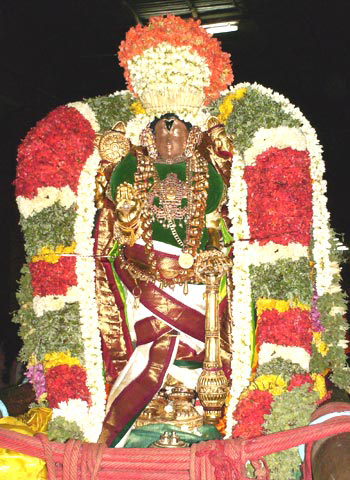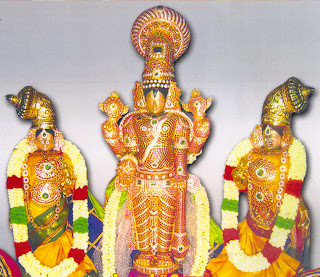Published from “Three Minutes” series written by A.S.Rajagopalan Swami of Ohio.
 Today, we will look into an introduction to mummaNikkOvai. Of the many works from R^ishi-s and AzhvAr-s to other preceptors, this terse hymn probably best reflects the essence shrI vaiShNavam. In addition to its superb meaning, its rhyme and tune are also equally enchanting. mummaNikkOvai
Today, we will look into an introduction to mummaNikkOvai. Of the many works from R^ishi-s and AzhvAr-s to other preceptors, this terse hymn probably best reflects the essence shrI vaiShNavam. In addition to its superb meaning, its rhyme and tune are also equally enchanting. mummaNikkOvai
mummaNikkOvai is the first and nava maNi mAlai is the last tamizh hymn (prabhandam) composed by svAmi deshikan while he was residing at tiruvahIndrapuram. Lord shrI devanAthan Himself appeared in svAmi deshikan’s dream and requested to sing in tamizh about Him to reflect all the essence of four veda-s. In tamizh, maNi means gemstone. deshikan has given the title of gemstone only to these two hymns; if that is so, one can imagine their importance relative to his other works.
Just like how AzhvAr hymns (nAlAyira divya prabhandam) squeeze out the ever-confusing, convoluted principles of holy scripts (veda-s and other pramANam-s) into direct, simple and sweet tamizh verses, svAmi matches that skill through squeezing his magnum opus shrImad rahasya traya sAram (The essence of three secret mantras) into a single hymn of 30 verses. One can also see that deshikan has used the same style of meter and the ideas present in nammAzhvAr’s four prabhandams.
mummaNikkOvai, as the name implies, has a special grammar style. Rules dictate that it must have 30 verses of which 3 different types of meters are equally distributed. It should also be in the style of antAdi (last word/clause of previous verse is the beginning word/clause of next verse). Unfortunately, only the first ten verses of mummaNikkOvai of svAmi deshikan are available and the rest have been lost.
In our tradition, usually three ratnas (gemstone) are mentioned: purANa ratna, mantra ratna and stotra ratna. Since this hymn is the essence of these three ratna-s, mummaNikkOvai is thus a perfect title for this stotram. purANeShu ca vaiShNavam, is an old saying. Of the 18 purANas, shrI viShNu purANa is the best, as considered by many, and is thus called purANa ratnam. Of all the mantra-s, the couplet (dvayam) is called mantra ratna because it packs all the meaning explicitly into such a small form. Stotra ratna by svAmi ALavandAr is the essence of all the three rahasyam-s (secrets) of shrivaiShNava philosophy. These three ratna-s put together is called mummaNikkOvai or ratna trayam. Here svAmi deshika’s mummaNikkOvai weaves all the three ratna-s to form a rare precious necklace.
Let us see how this composition of deshika is in synchronization with ratna trayam.
1. All the three ratna-s mention shrI mahA lakShmI first, before mentioning the Lord nArAyaNan. In fact, scripts claim that the way to identify the Lord is through shrI; pEyAzhvAr starts with, “First, I saw shrI” (tirukkaNDEn). Here svAmi deshikan allocated the first 10 verses (all that is available) to detail dvaya mantra and starts the first verse itself on shrI.
2. All the three ratna-s use the name nArAyaNan extensively. deshika’s work is no exception. One may ask how that is uncommon. For example, in navamaNimAlai, nArAyaNa is never explicitly mentioned. So, use of this term here is not accidental.
3. All the three ratna-s concentrate on Lord’s feet (pAdam, tiruvaDi) and so does deshika’s work.
4. All the three ratna-s expound on prapatti as the only plausible means. deshika’s work completes the same objective.
5. All the three ratna-s conclude with the meaning of namaH. The “I and mine” attitude should be eliminated and one should realize that everything belongs to the Lord. deshika’s work also concludes the same way.
deshikan is meticulous in his word selection, which lends to multiple, in some cases, more than 10 meanings. The first word of the hymn is “aruL”, meaning mercy. shrI is the embodiment of that mercy, kindness, patience, and compassion. Many scholars agree if the first word is about lakShmI, one need not worry about the first letter. svAmi deshikan himself explains this in tAtparya candrikA and says lakShmI means all auspiciousness (kalyANam, mangaLam, shubham). Here, svAmi beautifully starts with ‘a’ (akAram), the indirect name for lakShmI. If one looks into nammAzhvAr’s tiruvAimozhi, first verse itself indicates “aruL” which is the best route to reach the God. You can’t even think about Lord without His blessings. He is blessing you and that is why you are reading this mummaNikOvai and about lakShmI today.
We will continue to enjoy selected verses of this great hymn mummaNikkOvai later.
If I am to speak ten minutes, I need a week for preparation. If an hour, I am ready now.”










succinct and enlightening